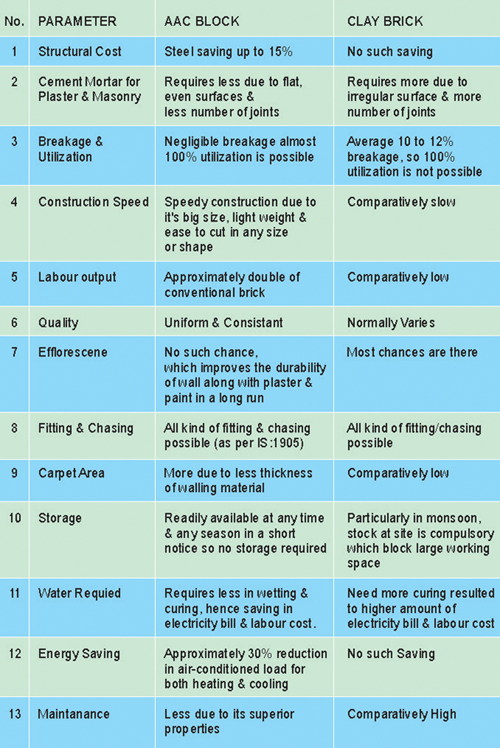
|
SATYAM BUILDTECH
Autoclaved Aerated Concrete (AAC) Blocks |

|

|
SATYAM BUILDTECH
Autoclaved Aerated Concrete (AAC) Blocks |

|
AAC blocks is porous concrete with tobermorite cellular structure. It contains 80% Air and 20% solids by volume. This makes AAC blocks lightweight building material for wall construction.
Due to this feature-porosity
other features comes hand in hand. Like it can be cast in larger shape still doesn’t bring much pain in handling. And construction becomes faster.
Porous structure not only brings thermal insulation feature but also
sound insulation, seepage resistance.
As in table following proportion of raw material are used along with water in manufacturing of lightweight blocks.

| AAC Blocks are Available in Following Sizes | ||
|---|---|---|
| Thickness (mm) | Height (mm) | Length (mm) |
| 100 to 230 | 200 | 600 |
Fire resistance :
AAC blocks falling into fire rating of 4 hrs makes it fire resistance wall material for building.
Pest resistance :
AAC blocks are Pest resistance since humidity, nutritional material and such Environment required to grow mold, insect, pest is not available in it.
No efflorescence :
Due to seepage resistance as well Absence of any salty material in production of blocks there is no chance of efflorescence in AAC blocks wall.
Allows No Water seepage :
Due to lowest “Water absorptive material”/ “Volume of block” ratio (only 20% in block compare to 65 % in brick) and absence of capillaries (So No capillary action), AAC blocks do not allow
water seepage of from exterior to interior of wall.
Gives High Sound Insulation :
AAC blocks falls in STC-44 (sound transmission class) which make it very low cost & good sound barrier material for residential and social buildings.
Gives High Thermal Insulation :
Because of Superior thermal insulation property of rating R30, AAC blocks do not allow effect of outer heat/cold on interior of building. This saves A/C cost by more than 30%.
Safety in Earthquake :
‘During Earthquake; Lightweight building is always more safe then heavy building’. Since lightweight AAC block reduces 60 % of dead weight of building; safety of building in earthquake increases.
With All in one kind of wall construction building material the AAC block is believed to be innovation of century in construction industry.

AAC (Autoclaved Aerated Concrete) Blocks, though largely new to many parts of India, it’s not a new building material. It was developed in SWEDEN in 1920, in response to increasing demands of timber supplies. AAC is lightweight building stone, comprised of all natural raw materials. AAC block is used in a wide range of commercial, industrial and residential application and has been in use in EUROPE over 90 years, the Middle East for the past 40 years and in America and Australia for 25 years. It’s an estimate that AAC now account for over 40% of all construction in UK and more than 60% of construction in Germany. In INDIA production of AAC block started in 1972. AAC is a lightweight, high strength building material and is produced in a veriaty of forms from blocks to structural floors and wall panels.
AAC is credited by LEED (Leadership in Energy and Environmental Design) and USGBC (US Green Building Council) as a ”green” alternative to traditional construction materials. Indian Green Building Council (IGBC) recommends its use in India.
AAC consists of 80% of Air. It is manufactured by combining silica in the form of recycled flyash, cement, lime, water and an expansion agent-aluminium powder and paving it into a mold. When added to concrete, the aluminium powder reacts with the silica, resulting in the formation of millions of microscopic hydrogen bubbles. The hydrogen bubbles cause the concrete to expand to roughly five times its original volume. The hydrogen evaporates and leaving a highly closed cell aerated concrete. It is then cut into blocks which are then steam and pressure cured in an autoclaved. Using AAC is very advantageous because it is environmentally friendly qualifies as a ”green” building material from manufacturing to recycling.
AAC is so lightweight, it weights 1/5” of the weight of the standard concrete, which results is lower transportation costs, faster work-flow lower material handling costs etc. AAC is in ’ready to build’ material, requiring no onsite curing time. It has unparalleled workability because it can be sown, drilled, nailed, screwed and milled with common hand tools.
The accurate panels are finished with very thin mortar joint producing a surface that requires minimum rendering. AAC possesses excellent structural integrity, resisting moisture penetration.
AAC has outstanding durability qualities over traditional materials, like humidity, freeze/thaw cycles and chemical attack. AAC is non-combustible. It offers the greatest fire resistance than any building material.
The use of AAC eliminates the need for applying costly fire proofing materials. AAC has extraordinary thermal insulating qualities and because of its unique physical structure. AAC provides much greater thermal insulation than conventional masonry.
Its relatively low consumption of low materials, excellent durability, relative cost effectiveness and the ability to be recycled. AAC has been aptly called the ”Superhero” of building materials.
One of the major advantages of AAC over other cementitious construction materials is its lower impact on environment. It has no efflorescence emission (white salt appearance) at large.
It is highly thermal insulating product used for both internal and external construction. It is easy and quick to install since the material can be routed, sanded and cut to size on site using standard carbon steel band saws, hand saws and drills. Major application of AAC products include light weight partition walls, protection of steel structure and lintels. The common sizes are (LxWxH) 600mm x 200mm x 200mm; 600mm x 150mm x 200mm; 600mm x 100mm x 200mm etc.